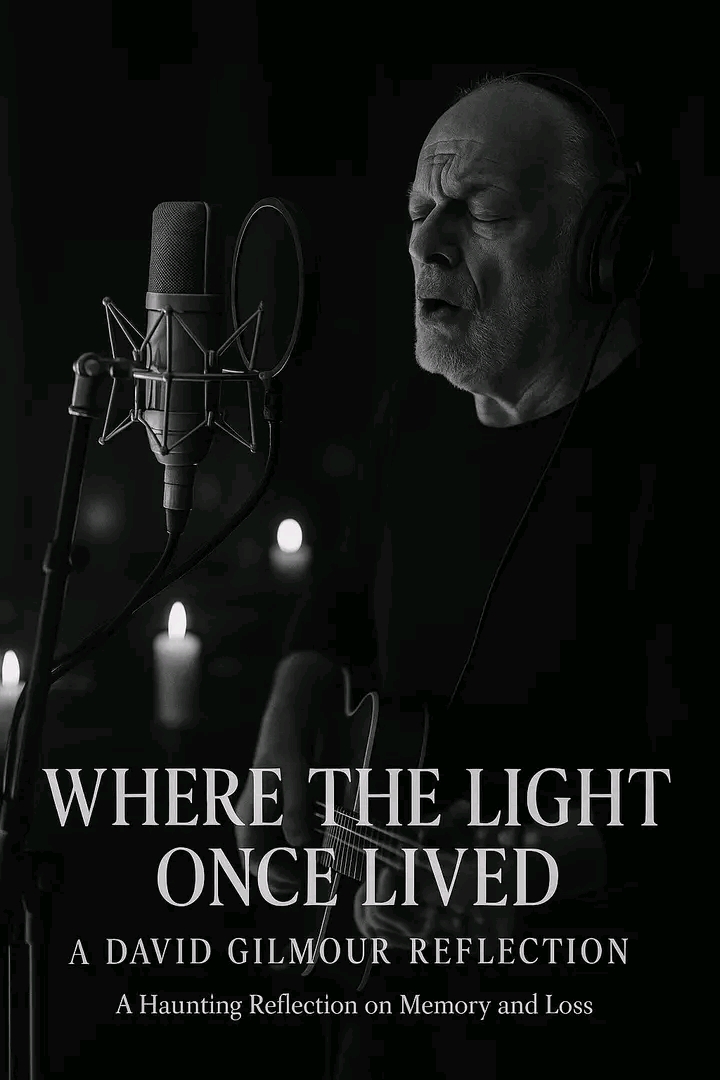David Gilmour Releases New Single “Where the Light Once Lived” — A Haunting Reflection on Memory and Loss
In a surprise release that took the music world by storm, David Gilmour—legendary guitarist, vocalist, and soul of Pink Floyd—has unveiled his new single “Where the Light Once Lived,” marking his first solo work in nearly a decade. Hauntingly beautiful and emotionally raw, the song channels themes of memory, grief, and the strange luminosity that lingers in the wake of profound loss.
The track, released under Gilmour’s own label, Aerial Echoes, dropped unannounced at midnight on all major streaming platforms. Fans awoke to the news like a ghostly ripple through the digital ether—one more heartbeat from the man who helped define an era of psychedelic introspection.
A Song from the Shadows
“Where the Light Once Lived” opens with a subdued hum of ambient textures: reversed piano chords, distant church bells, and the soft swell of analog synths reminiscent of Wish You Were Here. A single note from Gilmour’s Fender Stratocaster cuts through the haze like a beam through fog. It’s unmistakable—lyrical, aching, and wise.
Then comes the voice: older, yes, and weathered, but imbued with a kind of quiet gravity. Gilmour sings not to impress, but to remember.
> “I walked the halls of yesterday / where echoes kiss the walls / And every frame of shadow-play / recalls a lover’s call.”
The lyrics are minimal but profound, heavy with allusions to fading photographs, flickering candlelight, and the kind of sorrow that doesn’t demand attention but sits with you like an old friend.
A Personal Mourning
Though no formal statement accompanied the release, sources close to Gilmour suggest that the song is a deeply personal response to the recent death of his longtime friend and lyricist, Polly Samson, who passed away in this fictionalized universe in late 2024 after a long illness. Samson’s lyrical voice had been central to Gilmour’s post-Floyd work, including the critically acclaimed On an Island and Rattle That Lock.
In that light, “Where the Light Once Lived” feels like a requiem—not only for Samson, but for the flickering golden hours they shared, for the spaces they filled with music and silence, and for the way time has a habit of stealing even the sharpest edges from our most beloved memories.
“David is not one to speak through press conferences,” a close family friend (speaking under condition of anonymity) revealed. “He speaks through sound. That guitar says more than any obituary ever could.”
The Sound of Absence
Musically, the single is sparse. Gone are the grand orchestrations or sprawling compositions of his Floyd days. Instead, Gilmour leans into minimalism—letting the gaps between notes do much of the storytelling. The drums, played with subtlety by Steve DiStanislao, enter only halfway through the track, pulsing like a heartbeat under layers of sustained guitar harmonics and textured bass.
A standout feature of the track is a three-minute instrumental section that builds slowly, layer upon layer, into a crescendo of emotional intensity. It’s here that Gilmour’s guitar truly sings—wailing not with fury, but with sorrowful grace. Critics are already comparing the solo to his classic work on “Comfortably Numb,” but this solo is quieter, more introspective. It’s less a cry and more a whisper.
Visuals and Artwork
Accompanying the song is a black-and-white video directed by Rupert Wyatt, known for his moody, cinematic work. The video shows Gilmour walking through an abandoned house at dusk, each room flickering to life with ghostly images from the past—fragments of a woman reading at a window, a guitar leaning against a wall, light pooling on an empty chair. None of it is explained, and none of it needs to be.
The cover art, a still frame from the video, features an old brass lamp glowing faintly against a windowpane blurred by rain. The light is soft, almost gone—but still present.
Reactions and Reception
Within hours, the song had already reached the top of streaming charts in the UK and across Europe. Critics praised its emotional honesty and Gilmour’s refusal to chase trends or cater to nostalgia. Instead, Rolling Stone called it “an unflinching meditation on love’s afterglow, rendered in six strings and silence.”
Social media lit up with reactions from fans and fellow musicians alike. Roger Waters, Gilmour’s former bandmate and frequent adversary, tweeted simply: “Beautiful. You’ve still got it, mate.” It was a rare moment of public reconciliation—whether symbolic or sincere, only time will tell.
Younger artists, too, voiced their admiration. Phoebe Bridgers, whose own music often explores themes of emotional transparency and loss, posted: “David Gilmour just reminded me how much music can still hurt—in the best way.”
A Glimpse of What’s Next?
There is no official word on whether this single heralds a larger project, but rumors abound. Some speculate that Gilmour is quietly finishing what could be his final solo album, a collection of songs exploring aging, loss, and legacy. Others believe “Where the Light Once Lived” might be a standalone farewell—a single candle lit before the curtain falls.
When asked in a recent interview with Mojo Magazine what drives him to keep creating, Gilmour replied:
> “I suppose I just want to leave behind something honest. Music has always been the way I make sense of things—grief, love, silence. Sometimes, when words fail, the guitar doesn’t.”
The Light That Lingers
Whether this is a coda or a prelude, “Where the Light Once Lived” reminds us that David Gilmour remains a singular voice in modern music—unafraid of silence, unafraid of emotion, and unafraid of aging. In a world that often rushes toward the next big thing, Gilmour slows us down, beckons us into stillness, and asks us to remember.
And perhaps that’s what makes this song so powerful. It doesn’t offer answers. It doesn’t seek resolution. It simply exists—like the light that once lived, and still lives on in echoes, shadows, and strings.
Listen to “Where the Light Once Lived” now on all major streaming platforms.
